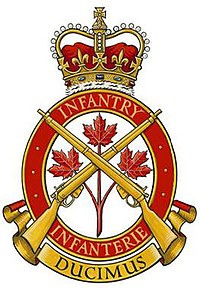Royal_Canadian_Infantry_Corps
Royal Canadian Infantry Corps
Infantry branch of the Canadian Army
The Royal Canadian Infantry Corps (French: Corps d'infanterie royal canadien) is the infantry corps of the Canadian Army and includes regular and reserve force regiments.
This article needs additional citations for verification. (February 2012) |
Originally formed as the Canadian Infantry Corps on 2 September 1942 to encompass all existing infantry regiments, including regiments of foot guards, in the Canadian Army. The corps was granted its "royal" designation in 1947 and was designated Royal Canadian Infantry Corps 30 April 1947, to be redesignated The Royal Canadian Infantry Corps 22 March 1948, and revert to Royal Canadian Infantry Corps 17 February 1964.[1]
The badge of the Royal Canadian Infantry Corps consists of Argent three maple leaves conjoined on one stem within an annulus Gules fimbriated and inscribed INFANTRY • INFANTERIE in letters Or, the whole ensigned by the Royal Crown proper set above a scroll Or inscribed with the Motto in letters Sable and surmounted by two rifles in saltire Or. The three maple leaves conjoined on one stem, taken from the Royal Arms of Canada, represent service to Canada, and the Crown, service to the sovereign. The crossed rifles denote infantry and have been used in badges of infantry units as well as of the officer cadet programme. Red and white are the national colours of Canada. "INFANTRY" and "INFANTERIE" are a form of the bilingual branch title and "DUCIMUS" is the motto of the corps.
In 1968, with the unification of the Canadian Army into the Canadian Armed Forces, the name of the Royal Canadian Infantry Corps was changed to simply the "Infantry Branch". As of April 2013, the traditional designation "Royal Canadian Infantry Corps" has been officially restored. Today, the administration and training of both the regular and reserve infantry that form part of the Canadian Army is the responsibility of the Infantry School (French: Ecole d'infanterie), which runs officer classification courses as well as NCO and Warrant Officer trades training at CFB Gagetown.
